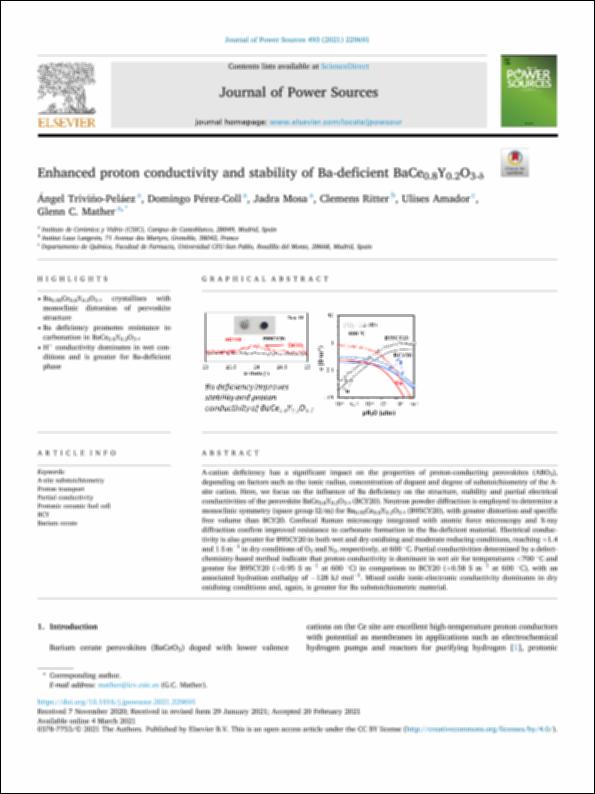Please use this identifier to cite or link to this item:
http://hdl.handle.net/10637/14783Enhanced proton conductivity and stability of Ba-deficient BaCe0.8Y0.2O3-δ
| Title: | Enhanced proton conductivity and stability of Ba-deficient BaCe0.8Y0.2O3-δ |
| Authors : | Triviño-Peláez, Ángel Pérez-Coll, Domingo Mosa, Jadra Ritter, Clemens Amador Elizondo, Ulises Julio |
| Keywords: | A-site substoichiometry; Proton transport; Partial conductivity; Protonic ceramic fuel cell; BCY; Barium cerate |
| Publisher: | Elsevier |
| Citation: | Ángel Triviñoo-Peláez, Domingo Pérez-Coll, Jadra Mosa, Clemens Ritter, Ulises Amador, Glenn C. Mather, Enhanced proton conductivity and stability of Ba-deficient BaCe0.8Y0.2O3-y, Journal of Power Sources, 2021 493 229691, DOI: 10.1016/j.jpowsour.2021.229691 |
| Abstract: | A-cation deficiency has a significant impact on the properties of proton-conducting perovskites (ABO3), depending on factors such as the ionic radius, concentration of dopant and degree of substoichiometry of the A-site cation. Here, we focus on the influence of Ba deficiency on the structure, stability and partial electrical conductivities of the perovskite BaCe0.8Y0.2O3-δ (BCY20). Neutron powder diffraction is employed to determine a monoclinic symmetry (space group I2/m) for Ba0.95Ce0.8Y0.2O3-δ (B95CY20), with greater distortion and specific free volume than BCY20. Confocal Raman microscopy integrated with atomic force microscopy and X-ray diffraction confirm improved resistance to carbonate formation in the Ba-deficient material. Electrical conductivity is also greater for B95CY20 in both wet and dry oxidising and moderate reducing conditions, reaching ≈1.4 and 1 S m−1 in dry conditions of O2 and N2, respectively, at 600 °C. Partial conductivities determined by a defect-chemistry-based method indicate that proton conductivity is dominant in wet air for temperatures <700 °C and greater for B95CY20 (≈0.95 S m−1 at 600 °C) in comparison to BCY20 (≈0.58 S m−1 at 600 °C), with an associated hydration enthalpy of −128 kJ mol−1. Mixed oxide ionic-electronic conductivity dominates in dry oxidising conditions and, again, is greater for Ba substoichiometric material. |
| URI: | http://hdl.handle.net/10637/14783 |
| Rights : | http://creativecommons.org/licenses/by-nc-nd/4.0/deed.es OpenAccess |
| ISSN: | 1873-2755 |
| Issue Date: | 4-Mar-2021 |
| Center : | Universidad San Pablo-CEU |
| Appears in Collections: | Facultad de Farmacia |
Items in DSpace are protected by copyright, with all rights reserved, unless otherwise indicated.


